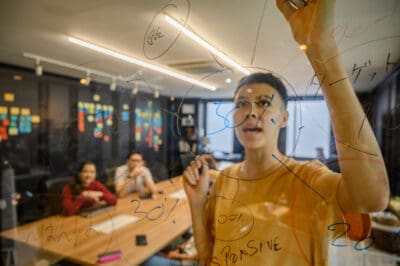
JFFLabs
JFFLabs is the Jobs for the Future innovation lab—we catalyze new ways to achieve our mission at JFF and with our partners. JFFLabs is the Jobs for the Future innovation lab—we catalyze new ways to…

June 2, 2022
Make Fast Studio and Jobs for the Future’s maturity model that maps workforce boards along a spectrum of customer and community engagement.
The public workforce system is one such institution, and as workforce leaders, we are learning how to identify and confront the inequities baked into our policies, procedures, and practices. As part of this shift, we recognize that the transformed labor market has left our current models of training job seekers and connecting them to employment inadequate for the communities we serve.
To address these core issues and aspirations, we identified human-centered design (HCD) as a critical lens, a language, and a set of practices to view and speak about organizational qualities and recommend concrete methods for behavioral and cultural change.
HCD thinking flips the problem-solving process on its head by exploring these issues through the eyes of customers, stakeholders, beneficiaries of services, and front-line staff. For workforce boards, adopting HCD to create programs, policies, and products requires examination of who they consider the “customer” and how that person’s voice is recognized and upheld throughout the organization. One of the most powerful aspects of human-centered design is that it starts with the assumption that everyone is more than just a customer, a worker, or an employer. This recognition of each constituent as a complete person helps us learn about one another’s needs, wants, and skills. It asks workforce leaders to consider which (if any) parts of their organization currently incorporate the voice of that person, how those insights are operationalized, documented, and formalized, and how they are woven into the underlying culture of the organization.
The research conducted led to the development of a “maturity model” that maps workforce boards along a spectrum of customer and community engagement. The maturity model includes four stages:
To build the maturity model, we mapped the behaviors identified in interviews to each stage of the model, broken down into five categories. Swipe to see each mapped against the related spectrum of engagement.
What Is Human-Centered Design?
A process of inspiration, ideation, and implementation that relies on the end-user as an active and empowered participant throughout the design and decision-making process, rather than giving limited input or only being informed of decisions, programs, or policies after the fact.
Starting in early 2021, funded by the James Irvine Foundation, a group of partners that included Make Fast Studio, Aspen Labs, JFF, Turning Basin Labs, and CivicMakers set out to explore the degree to which HCD principles were present in workforce boards across California and the country. The goal of this work was to develop a set of tools to help guide workforce boards toward discovering a more empathetic organizational posture. We hypothesized that by changing this approach, and the practices and policies that underlie it, workforce boards will deliver more equitable and meaningful outcomes to those they serve.
This is just the start. While our work here is a great stepping-off point, it remains incomplete as it captures only a fragment of the experience and perspective of workers, workforce board staff, and the many other stakeholders involved in this system. The next step is to implement and test this model and discover new tools for operationalizing the model with a cohort of workforce boards committed to working with their board members, elected officials, and other stakeholders.
Illustrations by Emily Shepard, Graphic Distillery

JFFLabs is the Jobs for the Future innovation lab—we catalyze new ways to achieve our mission at JFF and with our partners. JFFLabs is the Jobs for the Future innovation lab—we catalyze new ways to…

Future-Focused Workforce Board Behaviors | Workforce boards that design and implement human-centered systems and processes ensure that all people, regardless of their situation, have equitable access to services and opportunities. View the Full Brief Workforce…